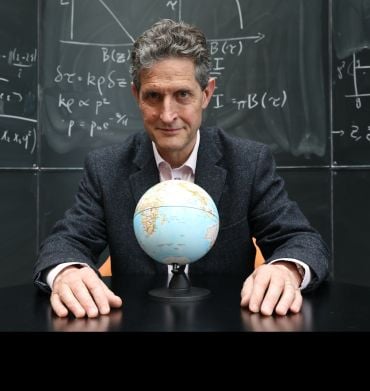
First use of weather forecasts to show human impact on extreme weather is ‘transformational’, Oxford scientists say
National forecasting centres like the Met Office could apply the same tools used for weather forecasting to quantify how human behaviour is aggravating major events like floods, heatwaves and storms, climate scientists at Oxford University Physics show in a study published today in Nature Communications.
Oxford climate physicists, led by Professor Myles Allen, have, for the first time, demonstrated how state-of-the-art weather forecasts can be used to show how greenhouse gas emissions affect extreme weather. In new studies of recent events in both the UK and U.S., they assessed the impact of global warming at a local scale and found that human activity both worsened specific weather events and made them more likely to occur.
We have shown for the first time that the same top-quality models used for weather forecasting, which are tested relentlessly every day, can be used to show the impacts of global warming. Multi-billion-pound decisions depend on adapting to climate change, so we need the most reliable means possible to inform them – and this is it.
Professor Myles Allen, Oxford University Physics
Their findings coincide with the United Nations “AI for Good Summit” in Geneva, where scientists from the Oxford Physics team will lead sessions on how artificial intelligence and machine learning can improve regional forecasting of extreme weather and future climate predictions.
'Weather forecasters could – and should – both warn people of extreme weather and explain how it is being affected by climate change,' said Professor Myles Allen, who leads the Oxford University Physics research team. 'It isn’t a simple case of climate change making all weather worse: some events, like prolonged winter cold, have become less likely.'
The new Oxford studies used the world’s most reliable medium range weather forecasting model, from the European Centre for Medium-Range Weather Forecasting, to assess the impact of climate change on extreme weather. A previous study, published in Environmental Research: Climate, focused on Storm Eunice in the UK, which reached wind speeds of 122 miles per hour and caused 17 deaths in February 2022.
 Professor Myles Allen, Oxford University Physics, Head of Climate Science. Credit: Martin Small.
Professor Myles Allen, Oxford University Physics, Head of Climate Science. Credit: Martin Small.‘Climate change and human influence is having a very clear impact on certain extreme weather like storms and heatwaves,’ said Dr Nicholas Leach (Oxford University Physics) who led the U.S. study. ‘Human influence made this 2021 heatwave at least 8 times more likely, and we also found the risk of similar heatwaves occurring is doubling every 20 years at the current rate of global warming.’
Understanding how climate change and human activity impacts extreme weather events remains a significant and urgent challenge because every year such events cost many lives and billions of dollars in aid and disaster relief around the world.
 A comparison between the limited resolution of current climate models (left) and next generation, higher resolution and more local models (right) created by the Oxford researchers. Credit: Oxford University Physics
A comparison between the limited resolution of current climate models (left) and next generation, higher resolution and more local models (right) created by the Oxford researchers. Credit: Oxford University PhysicsIn the UK, the cost of dealing with natural disasters caused by extreme weather and climate change could bankrupt the country by the end of the century, according to a recent report from the environmental intelligence agency Kisters. And in the U.S., the cost of dealing with 28 separate weather and climate disasters in 2023 alone topped a record US$90 billion.
Why only use a road atlas when you have a satnav available? Our climate models are like the old A-to-Z: tried and tested, but they have their limitations, especially when it comes to extreme weather. Using state-of-the-art weather forecast models allows us to quantify how human influence impacts extreme weather, to zoom in on local impacts, and to investigate the processes driving this, giving us greater confidence in our predictions.
Dr Nicholas Leach, Oxford University Physics
To investigate the impact of climate change on extreme weather, and assess the influence of human activity, scientists rely on computer modelling. However, climate models are often inaccurate at a regional or local level and only represent specific atmospheric processes at a coarse scale, making their predictions unreliable, especially for extreme weather like storms.
The Oxford teams overcame this by using high-resolution weather forecasting models to simulate extreme weather as if it had occurred in a world without human influence on climate, and in a warmer world of the future. Their models could simulate and predict even unprecedented weather events and can also be used to understand and quantify how human behaviour is changing them.
At the AI for Good summit in Geneva today, Professor Philip Stier of Oxford University Physics will convene a workshop with leading international experts to discuss future climate prediction systems. These are expected to make extensive use of artificial intelligence, to deliver more accurate predictions of the impact of climate change at local level.
The study ‘Heatwave attribution based on reliable operational weather forecasts’ has been published in Nature Communications.
 New Year Honours 2026
New Year Honours 2026
 New study estimates NHS England spends 3% of its primary and secondary care budget on the health impacts of temperature
New study estimates NHS England spends 3% of its primary and secondary care budget on the health impacts of temperature
 International collaboration launches largest-ever therapeutics trial for patients hospitalised with dengue
International collaboration launches largest-ever therapeutics trial for patients hospitalised with dengue
 Oxford-built multi-agent assistant for cancer care to be piloted in collaboration with Microsoft
Oxford-built multi-agent assistant for cancer care to be piloted in collaboration with Microsoft
 Adopting net zero technologies will save UK economy billions, finds Smith School analysis
Adopting net zero technologies will save UK economy billions, finds Smith School analysis
 New algorithm supercharges climate models and could lead to better predictions of future climate change
New algorithm supercharges climate models and could lead to better predictions of future climate change
 New training centre will bridge the gap between environmental science and AI to address global environmental challenges
New training centre will bridge the gap between environmental science and AI to address global environmental challenges